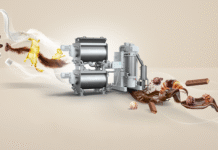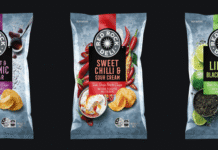
Greater processing in food and beverage segment in India will lead to increased demand for packaging, especially flexible packaging, Shiva Mudgil of Rabo Bank India said at the 8th Speciality Films & Flexible Packaging Global Summit 2019 that was held in Mumbai on 22-23 August.
“The aggregate, average level of processing of agricultural produce is less than 10%, with the existence of large, unorganized businesses in most of the food and agriculture sectors. This is very low compared to global standards. So, as more and more processing takes place, it bodes well for the Indian packaging industry,” Mudgil said.
The share of the organized market is still quite small, even in key sectors like dairy (24%) or poultry (less than 10%), he added.
Packaged food and beverages industry in India is estimated to be US$ 97 billion and is expected to grow at 11.8% CAGR value for the next five years. Processed food consumption in India is less than 10% of the total food consumption, he said. With increasing urbanization, changes in lifestyle and rising annual disposable income, demand for processed food will grow which will lead to higher demand for packaging.
The use of consumer food and beverage packaging in India is expected to grow at a CAGR of 6.4%, from 196.7 billion units in 2017 to 268.8 billion units in 2022, Mudgil said citing data from GlobalData. Within this segment, flexible plastic packaging has captured the lion’s share: 68% in 2017, he added.
“Flexible packaging is growing, owing to its inherent advantages of increased convenience, longer shelf life, lighter weight and lower costs versus other packaging materials. The expected rapid shift in some food categories – for example, rice, wheat flour, and pulses – from loose to packaged, will boost further growth in the flexible packaging segment. As a result, growth is also expected to continue at a faster pace than for other packaging materials, such as rigid plastics, paper-based, metal and glass,” Mudgil said.
Shifting consumption trends from loose to packaged food and then to convenient packaging will also drive demand for flexible packaging. Milk, spices and baked foods are the three main products that will see the biggest shift from loose to packaged, Mudgil argued.
Hectic M&A activity ahead
Mudgil also talked about trends in merger and acquisition activities in the Indian flexible packaging industry and said that hectic action will be seen at the converters’ level.
“Indian packaging industry is quite M&A intensive largely driven by inbound investment, especially at the converters’ level. This trend will continue in the future as well due to the fragmented nature of the industry. Acquisitions are likely to be driven by global players,” he said.
Outbound investment will be driven primarily by Indian packaging film manufacturers who want to diversify into value-added products. “We will see outbound interest from Indian companies who are looking to diversify outside of India, develop international footprints and gain foothold into the value-add segment. This trend will most likely remain limited to large film manufacturers,” Mudgil said.
IndiFoodBev — authentic, impactful and influential
An English-language food and beverage processing and packaging industry B2B platform in print and web, IndiFoodBev is in its third year of publication. It is said that the Indian food and beverage industries represent approximately US$ 900 billion in revenues which implies more than 20% of the country’s GDP. Eliminating the wastage on the farmside can help to deliver more protein to a higher number of the population apart from generating sizable exports. The savings in soil, seeds, water, fertilizer, energy and ultimately food and nutrition could be the most immense contribution that country is poised to make to the moderation of climate change.
To improve your marketing and grow sales to the food and beverage processing and packaging industry, talk to us. Our research and consulting company IppStar [www.ippstar.org] can assess your potential and addressable markets in light of the competition. We can discuss marketing, communication, and sales strategies for market entry and growth.
Suppliers and service providers with a strategy and budget for targeted marketing can discuss using our hybrid print, web, video, and social media channels to create brand recognition linked to market relevance. Our technical writers are ready to meet you and your customers for content.
The second largest producer of fruit and vegetables in the world is continuously expanding processing capacities and delivery systems with appropriate innovative technologies. We cover product and consumer trends, nutrition, processing, research, equipment and packaging from farm to thali. Get our 2025 media kit and recalibrate your role in this dynamic market. Enhance your visibility and relevance to existing markets and turn potential customers into conversations. Ask for a sample copy of our bi-monthly in print or our weekly IndiFoodBev eZine each Wednesday.
For editorial info@ippgroup.in — for advertisement ads1@ippgroup.in and for subscriptions subscription@ippgroup.in
Naresh Khanna – 10 February 2025
Subscribe Now











